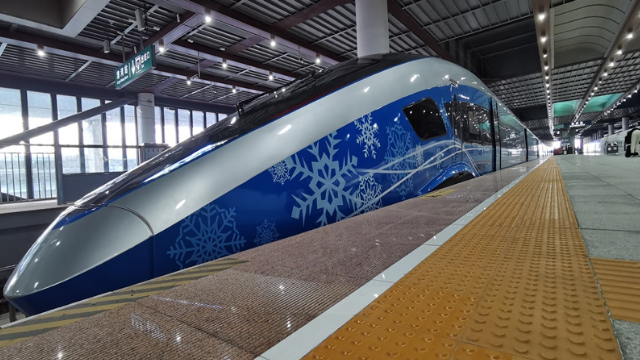The Fuxing high-speed train, with a top speed of 350 kilometers per hour, is the world’s first intelligent and autonomous high-speed train, and it includes a 5G live broadcast studio.

According to a senior designer, Olympic athletes and tourists will get a firsthand look of this one-of-a-kind electric multiple unit at the Beijing Games, which will take place from February 4 to February 20. (EMU).
The EMU contains a virtual reality environment in addition to a live broadcast studio capable of transmitting 4K footage over 5G networks. When the world’s fastest trains leave the station, they will be furnished with the world’s first installation of its kind, in a worldwide first.
According to Zhu Yan, deputy director of the CRRC Changchun Railway Vehicles Co, the train’s integration of so much contemporary technology proves China’s comprehensive leadership in railway systems and will surely help the country’s attempts to export electric multiple units.
Because of current materials and technology, the EMU’s wind resistance and weight have been lowered. Green EMUs like this one save 1.8 million kilowatt hours of electricity every year.
According to Zhu, the train’s latest cameras and sensors can detect any unforeseen track breaches up to 14 kilometers ahead.
Despite the fact that only around half of that amount will be served during the Olympic Games in Beijing, EMUs with eight cars can convey 564 passengers.
China has provided high-speed rail technology to Indonesia’s Jakarta-Bandung line, which passes through Jakarta. Almost all of the railroad work is finished.
A number of other countries, most notably Laos, use Chinese-made trains, but at slower speeds.
Aside from the country’s 4,000-strong domestic bullet train network, the next generation of smart EMUs might be useful.
When it comes to high-speed rail, China undoubtedly leads the globe. More than 40,000 kilometers of high-speed rail have already been constructed in the country, with another 1,400 kilometers scheduled to be completed by 2022.
The railway that connects Beijing with Zhangjiakou in Hebei Province, northern China, emerged in parallel with China’s railway industry.
The country’s first smart EMU was displayed on this length of track on the 110th anniversary of China’s first railway, commemorating the debut of the country’s first smart EMU.
The fact that Beijing and Zhangjiakou have connected all of the game sites, from Beijing’s indoor ice sports stadiums to Yanqing and Hebei Province’s outdoor ski resorts, is a significant advantage, according to Sun Zhang, a professor at Shanghai Tongji University and an expert in public transportation.
Sun said in an interview with the Global Times on Thursday that the facility will amaze guests, dignitaries, and sportsmen.
With a bullet train going at 350 kilometers per hour, it must be a massive operation to transmit ultra-high definition (UHD) films. The China Media Group (CMG), on the other hand, has never shied away from a challenging assignment.
Beijing and Zhangjiakou are connected through a high-speed train, which is why CMG unveiled a new livestreaming studio on Thursday, demonstrating China’s technological superiority.
The studio’s opening demonstrates CMG’s commitment to embracing technological innovation and reaching the biggest possible audience with quality coverage of the 2022 Olympics. The studio contains a revolutionary use of 5G+4K/8K+AI technology in UHD TV live broadcast on a high-speed rail system.
Also Read: Zhang Yimou to Direct Winter Olympics Opening Ceremony